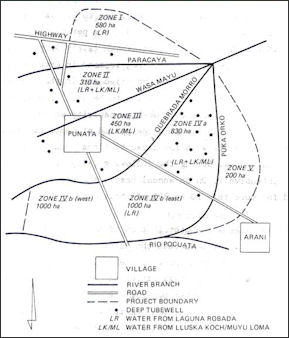SOLUTIONS TO WATER PROBLEMS
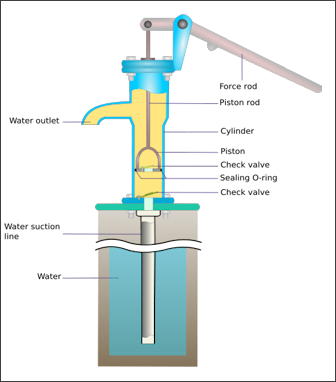
hand pump One of the goals of planners is took keep water cheap enough so that the poor can get what they need but have water prices high enough so that people do’swaste it. In many places water is subsidized, and the cheap prices encourage people to waste it. The obvious solution here is to end subsidies so that water is’swasted.
Reusing and recycling water is a solution. It is estimated that some cities can meet a fifth of their water needs by recycling water. Worldwide, two thirds of urban water does’seven get treated. Systems that treat and reuse wastewater are often the least costly and most efficient way to clean water but they have difficulty overcoming the aversion that many people have to drinking water derived from sewage.
Ultraviolet radiation is a popular means of disinfecting water but is less effective when the water contains sediments and sludge. In places where water is collected from dirty ponds and lakes, people have learned to clean the water by folding clean cloths several times, placing them over a jug, and pouring water through it. The cloth filters many kinds of disease-causing organisms.
Aids workers advise women to filter water through sari fabric folded over at least four times. In Bangladesh people have learned to clean dirty water taken from ponds and lakes by folding clean sari cloth over several times, placing it over a jug, and pouring thy water through it. The cloth filters many kinds of disease-causing organisms.
Women in Bangladesh have traditionally filtered surface water through a piece of cotton but this method only removes course debris. The best way to employ this method is fold the cloth to four or eight thickneses and wash and sun dry the cloth after each flitering. This method is good enough to remove all the zooplankton that carries diseases such as cholera.
There are major disagreement between agriculturalists and environmentalists on how available water should be managed. Water experts say that progress made in cleaning water and making it available at cheap prices has only encouraged more people waste it.
Water Conservation and Solutions to Water Shortages
Manual pump in Somalia Some old tried and true methods are being brought back such as harvesting, transporting and storing rain water. In some cases these technologies are being revived because modern technology has not supplied all the answers. System that use catchments, gutters and other channels, storage tanks and gravity or pump driven delivery systems, for example, are cheaper or at least equal in cost to drilling and building a well. Raised ridges up to 10 meters wide are alternated with shallow canals to channel water, either harvested rain or deviated river water. This not only helps to water crops but also stores heat and keeps the fields warm on cold nights.
Among the solutions to water scarcity are better water management, improved technologies to increase efficiency, higher prices for water to decease waste, conservation, investments by governments, the private sector and communities in basic water infrastructure, and cooperation among communities sharing water sources. Sachs wrote: “Most governments are poorly equipped to deal with serious water challenges. Water ministries are typically staffed with engineers and generalist civil servants yet lasting solutions to water challenges require a broad range of expert knowledge about climate, ecology, farming, population, engineering , economics, community, politics, and local cultures. Government officials also need the skill and flexibility to work with local governments, private businesses, international organizations, and potential donors.
The World Bank, International Monetary Fund, Asian Development Bank are all involved in funding water projects around the globe. Private companies are also involved. In Senegal, the world’s leading pipe maker JM Eagle donated 100 kilometers of piping that is used to bring water to tens of thousands of people.
Water-Extracting Methods and Low-Tech Water Technology
Low-tech technologies used to collect water in arid regions include: 1) fine mesh “fog catching” nets stretched between poles that collect usable water from fog; 2) “rooftop harvesting” using pipes that divert rain from rooftops into a cistern; and 3) desalination cones placed in saltwater. With the latter sun evaporates water, which condenses on the cones inner wall and trickles down into collection areas around the bottom edges.
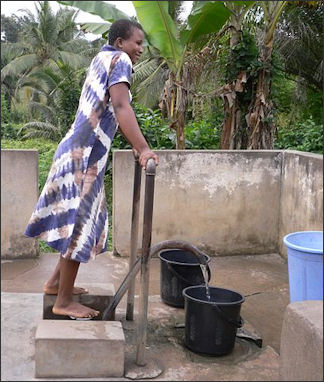
Pumping water in Jukwa Village, GhanaWater can be conserved by repairing leaky pipes, lining irrigation ditches to prevent leakage, covering irrigation ditches to prevent evaporation, using water-saving technology, and reducing water intensive crops like rice, cotton and sugar cane. Scientists have experimented with collecting dew with miles of nylon filament.
Among the low-tech water technology used to provide water and make it safe are: 1) filtration straws that trap disease-causing bacteria allowing people to safely drink untreated water (already over two million especially use such straws, which cost about $3 each, See LifeStraw,); 2) folding fine-weave clothing like an old sari four times to filter out pathogens like the cholera-causing bacteria; and 3) bamboo treadle pumps made up of inexpensive local materials that help farmers tap ground water to irrigate small plots of land.
Desert Agriculture Innovations
Some have recommended that farms install more rain saving devices and reduce waste on irrigation by finding leaky pipes, replacing water ditches with pressurized taps, and using trickle-down agriculture that deliver small, steady amounts of water directly to the roots of plants.
Low-tech hydroponic schemes pioneered by Brazilian engineer Jose Roberto Fonseca include: 1) sprouting plants in water laced with nutrients held in plastic Coca-Cola bottles feed with ultra thin tubes; 2) using seawater desalinated with a solar-powered desalinator; 3) catching water from a well on a hillock and using gravity to deliver it to gardens below; 4) storing water in underground cisterns; 5) pumping water with solar-powered pumps; and 6) using recycling systems that avoid evaporation and reduces waste.
So-called resurrection plants — grassy plants such as “Xerophyra viscosa “ found in the Drakenburg range in South Africa that can survive long periods without water and burst to life when it rains — are being mined for genetic material that can be inserted into corn and other crops that can help them grow in dry climates, with little or salty water and few fertilizer. “Xerophyra viscosa “ is being studied because it can grow on rocks at high altitudes, in thin souls in a variety conditions and very little water.
See Separate Article DESERT AGRICULTURE AND IRRIGATION factsanddetails.com
Efforts to Bring Clean Water to Villages
Reporting from southern Ethiopia, Tina Rosenberg wrote in National Geographic, “Today a U.K.-based international nonprofit organization called WaterAid, one of the world's largest water-and-sanitation charities, is tackling the job of bringing water to the most forgotten villages of Konso. At the time of my visit, Water-Aid had repaired five projects and set up committees in those villages to manage them, and it was working to revive three others. At the health center in Konso's capital, it was installing gutters on the sloped roofs of the buildings to conduct rainwater to a covered tank. The water is now being treated and used in the health center. [Source: Tina Rosenberg, National Geographic, April 2010]
tube wells plans WaterAid is also working in villages like Foro, where no one has successfully brought water before. Their approach combines technologies proven to last’such as building a sand dam to capture and filter rainwater that would otherwise drain away — with new ideas like installing toilets that also generate methane gas for a new communal kitchen. But the real innovation is that WaterAid treats technology as only part of the solution. Just as important is involving the local community in designing, building, and maintaining new water projects. Before beginning any project, WaterAid asks the community to form a WASH (water, sanitation, hygiene) committee of seven people — four of whom must be women. The committee works with WaterAid to plan projects and involve the village in construction. Then it maintains and runs the project.
The people of Konso, who grow their crops on terraces they have painstakingly dug into the sides of mountains, are famous for hard work, and they are an asset — one of Konso's few — in the quest for water. In the village of Orbesho, residents even built a road themselves so that drilling machinery could come in. Last summer their pump, installed by the river, was being motorized to push its water to a newly built reservoir on top of a nearby mountain. From there, gravity would pipe it down to villages on the other side of the mountain. Residents of those villages had contributed a few cents apiece to help fund the project, made concrete, and collected stones for the structures, and now they were digging trenches to lay pipes.
From a distance they looked like a riotously colored snake: 200 people, mostly women in rainbow-striped peplum skirts and red or green T-shirts, forming a wavy line up the side of the mountain from the pump to the reservoir. Some men were helping lay fat pipes in the trench. The scene was almost festive with the taste of progress. Hundreds of people had come every day for four days to spend their mornings digging. The trench was about half finished, and each day the snake moved farther up the mountain.
The Konso villagers own and control their pumps. Elected committees set fees, which cover maintenance. No one seeks to recoup the installation costs or to make a profit. Villagers told me that, after a few weeks, they realized paying a penny per jerry can is actually cheap, far less than what they were paying through the hours spent hauling water — and the time, money, and lives lost to disease.
Problems with Village Water Projects
Tina Rosenberg wrote in National Geographic, “Yet in many poor nations, vast numbers of villages where wells are feasible do not have them. Boring deep holes requires geological know-how and expensive heavy machinery. Water in many countries, as in Ethiopia, is the responsibility of each district, and these local governments have little expertise or money. "People who live in slums and rural areas with no access to drinking water are the same people who don't have access to politicians," says Paul Faeth, president of Global Water Challenge, a consortium of 24 nongovernmental groups that's based in Washington, D.C. So the effort to make clean water accessible falls largely to charity groups, with mixed success.[Source: Tina Rosenberg, National Geographic, April 2010]
The villages of Konso are littered with the ghosts of water projects past. In Konsos around the developing world, the biggest problem with water schemes is that about half of them fall into disrepair soon after the groups that built them move on. Sometimes technology is used that can't be repaired locally, or spare parts are available only in the capital. But other reasons are achingly trivial: The villagers can't raise money for a three-dollar part or don't trust anyone to make the purchase with their pooled funds. The 2007 survey of Konso found that only nine projects out of 35 built were functioning.
Sanitation and Clean Water Declared “Human Right” by the U.N
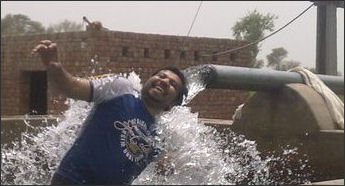
In July 2010, the U.N. General Assembly declared access to clean water and sanitation a "human right" in a resolution that more than 40 countries including the United States didn't support. The resolution adopted by the 192-member world body expresses deep concern that an estimated 884 million people lack access to safe drinking water and more than 2.6 billion people do not have access to basic sanitation. U.N. anti-poverty goals adopted by world leaders in 2000 call for the proportion of people without access to safe drinking water and basic sanitation to be cut in half by 2015. [Source: Associated Press, July 29, 2010]
AP reported: “The non-binding resolution, sponsored by Bolivia, was approved by a vote of 122-0 with 41 abstentions including the United States and many Western nations though Belgium, Italy, Germany, Spain and Norway supported it. Bolivia's representative said many rights have been recognized including the rights to health, life, and education. He said the Bolivian government introduced a resolution on the right to adequate water and sanitation because contaminated water causes more than 3.5 million deaths every year - more than any war.
Explaining why the U.S. didn't support the resolution, U.S. diplomat John Sammis told the General Assembly that the United States "is deeply committed to finding solutions to our water challenges," but he said the resolution "describes a right to water and sanitation in a way that is not reflective of existing international law."
The resolution calls the right to safe and clean drinking water and sanitation "a human right that is essential for the full enjoyment of life and all human rights." It calls on U.N. member states and international organizations to provide funding, technology and other resources to help poorer countries "scale up" efforts to provide clean, accessible and affordable drinking water and sanitation for all people.
On the U.N. Millennium Development Goals of cutting the the proportion of people without access to safe drinking water and basic sanitation cut in half by 2015, the latest U.N. assessment on progress toward achieving the goals said that "with half the population of developing regions without sanitation, the 2015 target appears to be out of reach" but it said "the world is on track to meet the drinking water target, though much remains to be done in some regions" especially sub-Saharan Africa and Oceania.
Providing Clean Water and Fighting Water-Borne Diseases
Studies have shown that providing clean water and sanitation can bring about tremendous benefits. People live longer, stay healthier and become productive while health care costs go down. People have realized the importance of clean water for some time. A tomb from ancient Egypt dated to 1450 B.C. depicts an elaborate filtering system. The ancient Greeks and especially the Romans devoted a lot of energy and resources to clean water.
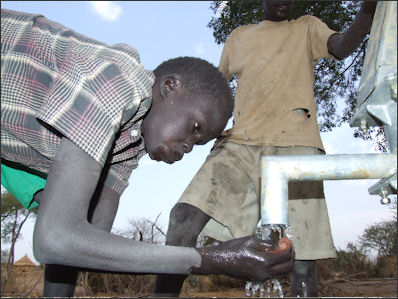
The chlorination of water is what saves many people in the developed world from water-bourne pathogens and toxins. The discovery of chlorine as a germ-killing agent took place in the early 1900s. Chlorination began in the United States around 1910. Among the diseases it conquered was typhoid, which was reduced from causing around 25 deaths per 100,000 a year to almost none. Chlorine is effective against many disease-causing agents but not all of them. But it remains a cheap way to fight water-bourne disease.
In the developed world before chlorinating water became common place cities combated water-born diseases by having water piped in from remote locations and separating water supplies. These days more and more pathogens are emerging that get past chlorinizaton and scientists worry about mutations that might produce a really nasty germ that could kill thousands or millions.
The LifeStraw, a cylindrical devise about the size of bicycle pump that is placed into water and sucked through, has shown great promise in tackling water-bourne disease . Produced by the Danish company Vestergaard Frandsen S.A. , it costs $3 per unit and consists of layer of increasingly-fine mesh filters that strain out most bacteria and iodine beads that kill remaining bacteria as well as viruses and parasites. Active carbon neutralizes the taste of the iodine and blocks out remaining parasites. Devises sold in 2007 did not filter out the common parasite “giardia lamblia” but the company was working on a device that did.
Mikkel Vestergaard, inventor the 20-centimeter-long device, told Newsweek, “You have to suck pretty hard at first to get it moist, but after that it’s easy.” It can filter up to 185 gallons of water, about a year’s worth of use, before needing to be replaced. His company is also a major maker or mosquito nets and malaria-fighting, insecticide-coated sheeting.
Water Pricing and Waste-Water Recycling
Pricing water to make it more dear is increasingly being seen as the primary solution to the world’s water problems. When water prices were significantly raised in the United States in the 1960s and the money was used to improve irrigation, push low-capacity toilets and build water treatment facilities and the like, per capita water consumption fell by more than a quarter. In the developing world, however, it is hard to take similar measures because people are simply too poor to absorb any increase in water prices.
In the developed world where water shortages are acute, governments are increasingly looking into waste-water-recycling plants that can recycle sewage into a drinking water. One such plant in Orange County, California cost $480 million to build and requires $29 million annually to run. At this facility dark brown sludge that enters the system first goes through vertical tubes filled with polypropylene tubes that thickness of dental floss that are filled with holes 1/300th the size of a human hair that filters out many bacteria and protozoa as well as nasty “suspended solids.” Every 20 minutes are so there is a backwash or water and air blasts the tubes clean.
After that the water is pumped into the reverse osmosis chambers where it is mixed with sulfuric acid to lower the pH and pushed though several sheets of plastic membranes that removes salts, viruses and pharmaceuticals. After this hydrogen peroxide, a disinfectant, is added to the water which is then zapped with ultraviolet light, and decarbonized. For a final step lime is added to raise the pH. The result: clean water.
Privatizing Water
Many feel the solution to the world’s water problems is privatizing it. Siemens, GE and Dow are among the companies that have realized there is money to be made in water. Much of their focus has been on water treatment and gobbling up companies in this sector in preparation for long term strategies. Many are looking to the Middle East, which is awash in oil money but is lacking in fresh water, and China which also suffers from water shortages and is becoming wealthy enough to pay for big projects.
WaterAid and other successful groups, such as Water.org, CARE, and A Glimmer of Hope, also believe that charging user fees — usually a penny per jerry can or less — is key to sustaining a project. The village WASH committee holds the proceeds to pay for spare parts and repairs.
As it stands the private sector supplies water for only 5 percent of the world’s population. In the mid 1980s, the World Bank pressured governments in Asia and Latin America to privatize and deregulate water and utility services and open them up to the private sector. The results were disastrous. Companies demanded price increases to pay for modernization and expansion. Governments initially went along but public protests causes them to change their minds. Many projects were killed after the companies had already made sizable investments and foreign companies got burned as governments broke their promises with them.
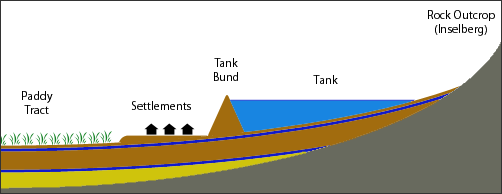
Cross section of dry zone Catena of Sri Lanka
Problems with Privatizing Water
But there is a lot of resistance from users and potential suppliers. Villagers think of water as a gift from God. Should they pay for air too. In some circles there are even calls to make water a human right. Business also has its doubts. Companies say water requires a high initial investment but “the payback period is long, rate of return low and the risks are high.” Companies want assurances from partner governments and possibly the World Bank that they will get a reasonable rate of return to justify long term commitments. One of their primary reservations is that they will invest large amounts hard currency and be paid in worthless, local currency.
Tina Rosenberg wrote in National Geographic, “Water and money have long been an uneasy mixture. Notoriously, in 1999 Bolivia granted a multinational consortium 40-year rights to provide water and sanitation services to the city of Cochabamba. The ensuing protests over high prices eventually drove out the company and brought global attention to the problems of water privatization. Multinational companies brought in to run public water systems for profit have little incentive to hook up faraway rural households or price water so it is affordable to the poor. [Source: Tina Rosenberg, National Geographic, April 2010]
Yet someone has to pay for water. Although water springs from the earth, pipes and pumps, alas, do not. This is why even public utilities charge users for water. And water is often most expensive to provide for those who can least afford it — people in the remote, sparsely populated, drought-stricken villages of the world.
"The key question is, Who decides?" says Global Water Challenge's Faeth. "In Cochabamba nobody was talking to the very poorest. The process was not open to the public." A pump in a rural village, he says, is a different story. "At the local level there is a more direct connection between the people implementing the program and the people getting access to water."
Water Services
Water services is getting to be a big business. The industry basically provides four services: 1) purifying water; 2) delivering it to households and businesses; 3) cleaning up water that leaves those homes and businesses; and 4) extending and repairing the networks of pipes, pumps and plants. These services may sound simple but they can be highly complex and expensive to execute.
Increasingly the argument is being made that they best way to deal with water and the problems of delivering efficiently and safely is to put in the hands of the market. If supples are short raise the prices and let the laws of supply and demand decide its fate. If it is dirty let the market define what its takes to make it clean.
But in many cases things are not so simple. If prices are raised too much poor people can not afford it and sometimes people get so upset they fill the streets and protest. It is not uncommon for water companies to pull out of deals and cancel contracts is the situation gets too volatile. Water is different from other commodities in that it is so vital for living. People can not really say this water is too expensive I’ll buy something else.
In the old days many water suppliers were private companies. Later it was deemed more appropriate for everyone to have access to water and consequently water became controlled by public systems. In recent years as demand for water has risen and the expense of delivering has risen a number of countries and municipalities — some of them quite poor — are tuning to the private sector for help.
Veolia and Other Water Service Companies
The three largest water service companies in the world are European. France-based Veolia is perhaps the best known. Originally known as the Compagnie Generale des Eaux, it was founded in 1853 by Napoleon III, France’s last emperor, and funded by Baron de Rothschild and Charles Lafitte. It was created to help implement the emperor’s plan to modernize France and over the decades built much of France water infrastructure. It began offering it services international ly after it helped clean up the Siene (the river that flows through Paris) and figured the techniques it used to clean the Seine could be used elsewhere.
In the 1980s the company changed its named to Vivendi and went on acquisition binge, purchasing among others Seagrams (for $34 billion ) and the publisher Houghton Mifflin and became a huge entertainment conglomerate with 2,000 subsidiaries, most of them having nothing to do with the water business. By the late 1990s the company was overextended and so baldy in debt it verged on collapse. To raise cash it sold off Vivendi Environment — the original water company. In 2003, the company was renamed Veolia to avoid any association with its former parent company.
The C.E.O. of Veolia is Henri Proglio, a Frenchman who scoffs at the corporate world, claims to never have owned a tuxedo and asserts his company is in business to be environmentally responsible. Proglio told the French newsweekly Le Point in 2005, “Water, like oil, is getting scarcer, We’re living on Earth in 2005 with the same water that was available in 1900. While in the meantime the global population has quadrupled.”
Suez, a descendant of the company that built the Suez Canal in 1860, is another large France-based water company. As of 2006 it ranked 90th on the Forbes list of the world’s 2,000 largest public firms. It operates in 32 countries and had $58.6 billion in revenues in 2006. Suez has grown fast in recent years, acquiring Lyonnaise des Eaux, one of France’s largest utilities in 1997.
Thames Water provides water for most of London. Described by the left-leaning Independent newspaper as “Britain’s most hated utility,” it took its present form in 1989 during a wave Thatcher-era privatizations. In the 1990s it expanded internationally and was bought by the German energy combine RWE and then by a consortium headed by Macquarie, Australia’s largest investment bank. Veolia, Suez and Thames dwarf the water service companies in the United States.
The water service businesses claim they are doing the world a favor and say they can deliver water in the same way that private companies can build better cars than governments. Some analysts say that thus far that may be true in democracies where the public has some recourse if they don’t like what is happening but is not necessarily the case in places with strong governments like China, where the government-supported water companies can call the shots and the public has little recourse if they don’t like the situation.
Iceberg Catching and High-Tech Water Technology
Scientists are beginning to seriously study things like transporting icebergs as a way to alleviate global water shortages. Icebergs that have reached a size of 160 kilometers long, 70 kilometers long and 250 meters thick have been observed. A large iceberg can take eight to 12 years to melt completely. Winds and currents often carry them 40 to 50 degrees south latitude.
Technology currently exists to “catch small icebergs up to 0.1 cubic kilometers in size, and tow them to the African coast with powerful tugboats, The biggest obstacle to overcome is wrapping the iceberg in a protective film to keep the ice from thawing en route. Another idea is breaking up the icebergs where they are found and loading the broken ice into tankers.
Others are exploring weather modification. A wind powered spray turbine mounted on an anchored platform in the ocean sucks in ocean water through pipes then filters and sprays fine droplets into the sky. The humidified water produces clouds and rain.
See China
Obstacles to Combating Water Shortages
One of the main obstacles to combating water shortages is that government prefer to spend money on other things. Peter Rogers, a Harvard environmental engineering professor, told U.S. News and World Report: governments and the private sector “want to invest in energy, telecoms, highways, high-speed trains, you name it...the problem is [water] yields social benefits, so no one individual can afford to do it.”
Money is on water is drying up. In the late 1990s, public spending on water and sanitation was 2 percent of the GDP of most countries, By the late 2000s it had dwindled to less than 1 percent as countries devoted more money to education, roads and other needs. Foreign assistance for water-related issues has stagnated at about $15 billion a year. The World Bank has said a minimum of twice that amount is needed. The United States spent about $1.7 billion on water-related aid from 2003 and 2005, with a good chunk of that going to Iraq and Afghanistan.
One paradox with water is that efficiency can make matter worse on an economic level. The more water that is conserved the less money is earned by utility company that use their revenues to improve water infrastructure. Some policy makers say the solution to this is to creating a public fund for water like the one that finances highway construction with a tax on gas.
Image Sources: Wikimedia Commons
Text Sources: New York Times, Washington Post, Los Angeles Times, Times of London, Yomiuri Shimbun, The Guardian, National Geographic, The New Yorker, Time, Newsweek, Reuters, AP, Lonely Planet Guides, Compton’s Encyclopedia and various books and other publications.
Last updated April 2022


